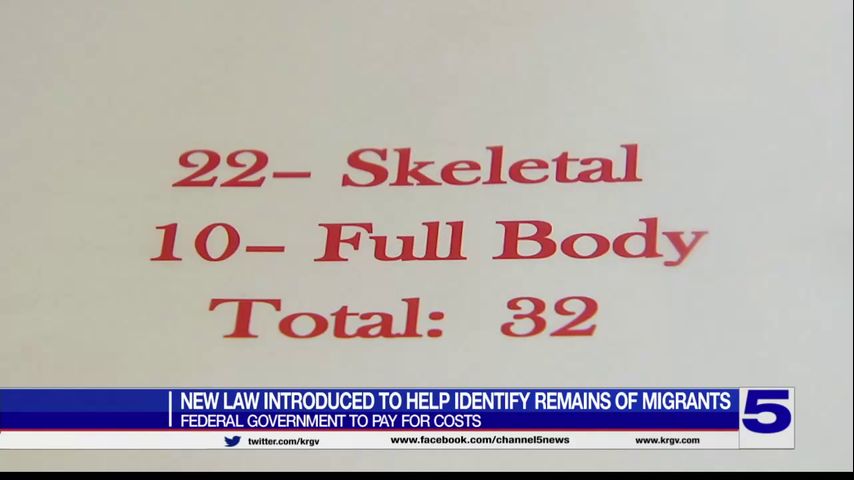New law introduced to help identify remains of migrants
Every year, Hidalgo County Sheriff Eddie Guerra and his deputies are called out to areas along the Rio Grande to investigate the cause of death and identify migrants.
"It is a lengthy process, especially if the individual does not have any forms of identification," Guerra said.
The process includes identifying the person and finding their family, which comes with a hefty price across counties throughout the southern border.
Brooks County Sheriff Benny Martinez said that between 2009 and 2012, Brooks County inherited a tab of about $680,700.
"We spend between $1,400 and $4,000 per case," said Congressman Vicente Gonzalez. "So, it's a heavy burden for some of our poorer, rural communities."
The Missing Person and Unidentified Remains Act, introduced by Congressman Vicente Gonzalez and Will Hurd, was signed into law on Jan. 1 by former President Trump.
Now, the federal government will cover the cost, instead of border communities taking the hit.
"We've been paying out of our taxpayer dollars to gather remains and connect, gather DNA evidence of people who die in our fields, in our desserts across the country from Texas all the way to California," Gonzalez said.
State and local governments can apply for government-funded grants that will cover fingerprinting, medical examiners, DNA forensic laboratories and the cost of transporting, reporting and identifying missing people and unidentified remains.
The new legislation also includes putting out more life-saving beacons so migrants can call for help if they're lost in the ranch lands.
The Missing Persons and Unidentified Remains Act will:
- Expand eligibility for grants to allow applications from State and local governments; accredited government-funded Combined DNA Index System (CODIS) forensic laboratories; medical examiners; accredited publicly-funded toxicology, crime, and university forensic anthropology center laboratories; and nonprofit organizations who have collaborative agreements with State and county forensic offices for entry of data into CODIS or National Missing and Unidentified Persons Systems (NamUS).
- Require reporting to the National Crime Information Center (NCIC) and NamUS regarding missing persons and deceased individuals found in each applicant’s jurisdiction.
- Add privacy protections for biological family reference samples that will be uploaded into CODIS by precluding disclosure of such information to Federal or state law enforcement agency’s for criminal law enforcement purposes.
- Authorize the use of grant funds to cover costs for the:
- transportation, processing, identification, and reporting of missing persons and unidentified remains;
- hiring of additional DNA case analysts and technicians, fingerprint examiners, and forensic odonatologists and anthropologists needed to support identification; and
- purchase of state-of-the-art forensic and DNA-typing and analytical equipment.
- Expand U.S. Customs and Border Protection’s (CBP) legal authorities to allow for the purchase of additional self-powering 9-1-1- cellular relay rescue beacons to mitigate deaths in places where CBP determines are appropriate.
- Add reporting requirements for the NamUS Program regarding the number of unidentified person cases, anthropology cases, suspected border crossing cases and associations made.
- Add reporting requirements for CBP and the Government Accountability Office (GAO) on unidentified remains and use of rescue beacons.




